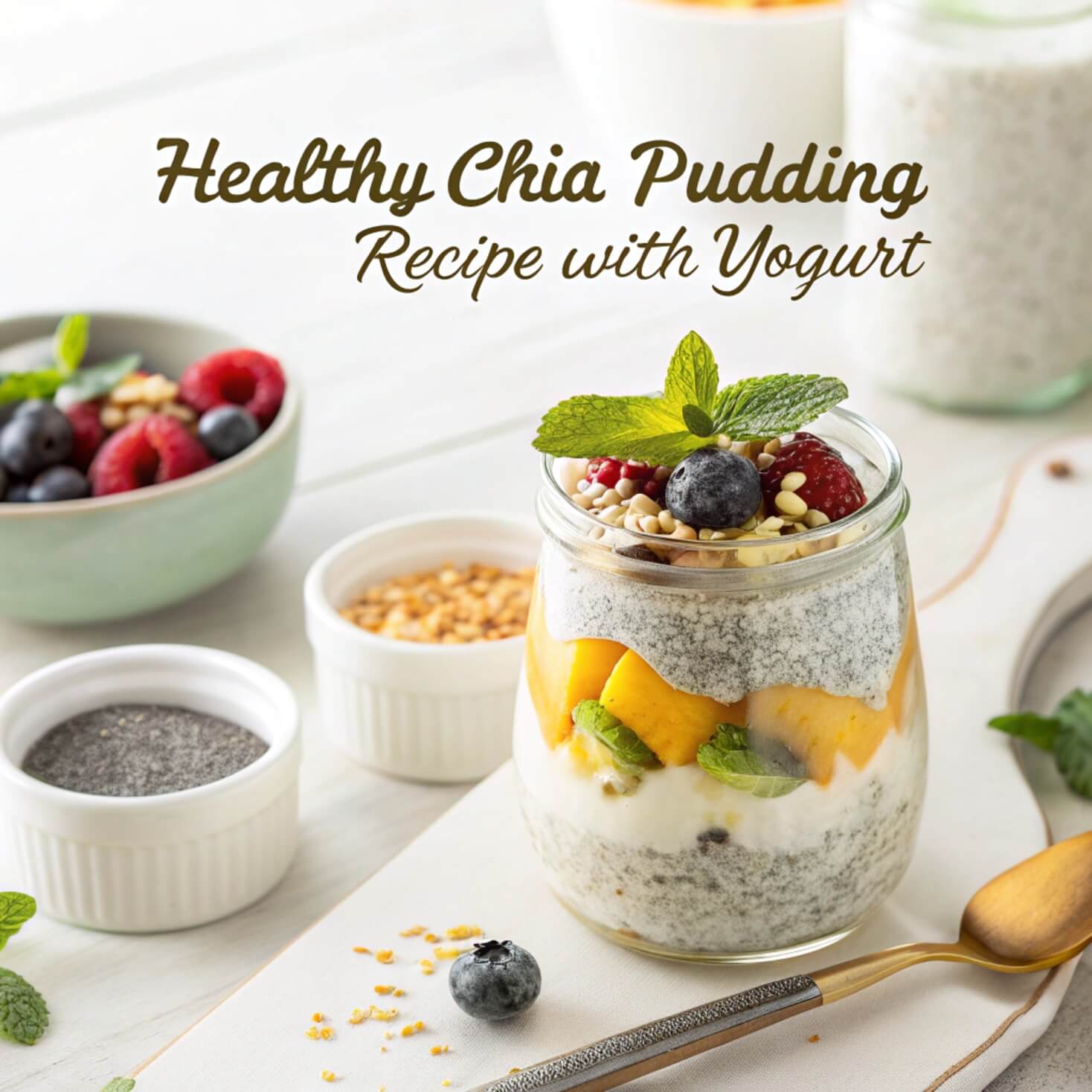How to Make Healthy Chia Pudding with Yogurt
What is Chia Pudding, and what are its benefits?
Chia pudding is a simple breakfast or snack in which chia seeds absorb liquid to form a gel-like texture. These small seeds from the Salvia hispanica plant deliver a powerful nutritional punch. Combining chia seeds with yogurt gives you a creamy, protein-rich delight that will satisfy you for hours.
Many individuals skip breakfast because they do not have time to cook in the mornings. Chia pudding fixes this issue. You prepare the items the night before and have breakfast ready when you get up. No cooking is required! A mother from Texas wrote to tell me that she prepares yogurt chia pudding for her three children every Sunday night, and it keeps them energetic throughout the week for their morning lessons.
Ingredients for Yogurt Chia Pudding
To create a simple yogurt chia pudding, you will need the following:
- 2 tablespoons chia seeds.
- 1/2 cup Greek yogurt, plain or vanilla.
- 1/4 cup milk (any sort is OK)
- 1 tablespoon honey or maple syrup.
- 1/4 teaspoon of vanilla essence.
- Pinch of salt.
That is it! These basic components provide a foundation that may be enhanced with fruits, nuts, spices, or other toppings.
Essential Ingredients for Yogurt Chia Pudding
The Power of Chia Seeds
Chia seeds are small, but they perform wonders in this dish. These small black or white seeds may absorb up to ten times their weight in fluids, generating a pudding-like texture without cooking or specific equipment.
Chia seeds may be found in most supermarket shops, other seeds, or in the health food department. Black and white chia seeds function and taste the same. The only variation is how they appear in the pudding. White chia seeds work well with yogurt for a cleaner appearance.
Keep your chia seeds in an airtight container in a cold, dry location. If you get new ones, they may endure up to two years in this manner.
Choo if they smell rotten or unpleasant-sing the Right Yogurt
The yogurt you choose significantly impacts your chia pudding’s final flavor and texture. Greek yogurt thickens the pudding and provides additional protein, while regular yogurt produces a lighter texture. Plant-based yogurts such as coconut or almond are ideal for dairy-free diets.
For the most outstanding results, use plain yogurt with your sweetener. This allows you to customize the sugar content. Pre-sweetened yogurts often include more sugar than necessary, which might make your pudding too sweet.
A California lady reported using half Greek yogurt and half coconut yogurt to get the ideal creaminess and taste ratio. This combo combines Greek yogurt’s protein boost with coconut’s tropical flavor.
Liquid Options and Ratios
The liquid you add allows the chia seeds to swell up appropriately. While milk is the most popular, you may use any liquid:
- Dairy milk: whole, 2%, or skim
- Plant milk (almond, coconut, oat, and soy).
- Fruit juice (different taste)
The fundamental ratio is two tablespoons of chia seeds to 1/2 cup yogurt and 1/4 cup liquid. If you like a thicker pudding, use less liquid. Add extra to get a thinner consistency.
Step-by-step Recipe Guide
Basic Yogurt Chia Pudding Method
Making chia pudding with yogurt requires just minutes of active preparation. Follow these easy procedures to get great results every time.
- Add the yogurt, milk, sugar, vanilla extract, and salt to a whisker until smooth. Transfer to a dish or jar. A mason jar works well since it can be covered and shaken.
- Add the chia seeds and mix quickly. Continue stirring for approximately 30 seconds to avoid clumps.
- Stir again: After 5 minutes, stir to break up any formed clumps. This step is essential for a smooth pudding.
- Cover the container and refrigerate for at least 2 hours, ideally overnight. It grows thicker as it sits for longer.
- Check consistency: Before serving, make sure your pudding has attained the correct thickness. If it’s too thick, add a little more milk. If the mixture is too thin, toss in a few more chia seeds and refrigerate for 30 minutes.
A teacher from Oregon informed me that on Sunday evenings, she prepares individual amounts in little jars. She gets one before heading to work every morning, saving significant time.
Common Mistakes To Avoid
Even with such a basic recipe, there are a few hazards to avoid:
- Clumping: If you don’t mix the chia seeds well enough, they will clump into gelatinous balls. Break up any clumps with a fork and aggressively whisk to remedy this.
- Incorrect ratio: Too many chia seeds make the pudding overly thick and gummy. Too few, and it remains runny. Begin with the suggested ratio and modify each time depending on your preferences.
- Not enough time: If you rush the procedure, you’ll end up with crunchy chia seeds instead of creamy pudding. Give it at least two hours, preferably overnight.
- Forgetting to stir twice: After 5 minutes, a second stir is required to ensure uniform seed dispersal.
Flavor Variations and Add-Ins
Sweet Flavor Combinations.
The basic yogurt chia pudding recipe may create endless flavor combinations. Here are some popular sweet varieties:
Berry Bliss: Combine 1/4 cup of mixed berries (strawberries, blueberries, and raspberries) with the original recipe. For a more pungent taste, crush half of the berries before adding.
Tropical Paradise: Add two tablespoons of shredded coconut and 1/4 cup sliced pineapple or mango. A splash of coconut essence heightens the tropical taste.
Apple Pie: Add 1/4 teaspoon cinnamon, two tablespoons chopped apples, and one teaspoon chia seeds. Sprinkle with granola for crunch.
For chocolate lovers, add one tablespoon of chocolate powder and an additional teaspoon of sugar to the basic recipe. Before serving, add a few dark chocolate chips.
Peanut Butter Cup: Swirl in 1 tablespoon of natural peanut butter and one teaspoon of chocolate powder. For an added treat, sprinkle a few chocolate chips on top.
A college student said she creates chocolate peanut butter chia pudding in bulk to feed her late-night study sessions with a healthier alternative to vending machine treats.
Savory Options for Chia Pudding
While most people associate chia pudding with sweetness, savory variations provide a distinct twist and are ideal as snacks or light meals. Try out these tasty ideas:
- Mediterranean: Combine the basic pudding (without the sugar) with one tablespoon of chopped olives, one tablespoon of diced cucumber, one teaspoon of lemon juice, and a sprinkle of dried oregano.
- Avocado: Blend 1/4 ripe avocado into the yogurt before adding the chia seeds. Add a touch of garlic powder, salt, and lime juice.
- Everything Bagel: Combine one teaspoon of everything bagel seasoning with the basic mixture. Before serving, add a couple of tiny pieces of cream cheese.
A chef from New York informed me that she serves little pieces of delicious chia pudding as an appetizer at dinner gatherings. Her visitors never realize the creamy foundation includes chia seeds.
Creative Toppings to Upgrade Your Pudding
The appropriate toppings enhance the chia puddings, taste, and visual appeal of your the following options:
Crunchy Elements include toasted nuts (e.g., almonds, walnuts, pecans) and granola clusters.
- Toasted coconut flakes
Cacao nibs - Hemp Seeds
Fresh fruits include sliced bananas, diced apples or pears, berries, pomegranate seeds, and citrus segments.
Sweet Drizzles: Honey or maple syrup.
Warm nut butter with fruit compote or jam.
- Melted dark chocolate.
- Date Syrup
Tips for Making Ahead and Storing
Batch Preparation Strategies
Preparing chia pudding in batches saves time and ensures that you always have a nutritious snack. Here’s how to increase efficiency:
Weekly prep: On Sunday, set aside 15 minutes to make 4-5 servings for the week. Use separate containers for easy grab-and-go convenience.
Dry mix preparation: Combine more dry ingredients (chia seeds, sweetener, spices, etc.) and store in labeled jars. When ready to prepare pudding, combine the wet ingredients.
Topping station: At the start of the week, prepare a variety of toppings in little containers. This provides a “chia pudding bar” where family members may make their portions.
Layer preparation: For more complicated tastes, make the base pudding in one big batch, then split and add various flavor add-ins to individual servings. Label each with masking tape for easy identification.
A busy mom said she organizes a weekend “pudding prep session” when her children prepare their jars with their preferred mix-ins. This encourages children to be enthused about having a healthy breakfast.
Proper Storage Methods
Proper storing will keep your chia pudding fresh and tasty for many days.
Containers: For optimal results, use glass containers with tight-fitting lids. Mason jars, tiny Pyrex containers, and recycled jam jars work nicely. Avoid using metal containers, as they may influence the flavor.
Refrigerator life: Chia pudding may be kept in the refrigerator for 5-7 days when properly refrigerated. The texture may thicken with time; add a splash of milk before serving.
Freezing options: You can freeze chia pudding! Freeze in ice cube trays and then transfer to a freezer bag. Thaw separate servings in the refrigerator overnight.
Symptoms of spoilage: If your pudding develops an unpleasant odor, changes color abruptly, or displays symptoms of mold, throw it right away.
Separation: Don’t be concerned if you see some liquid separation after storage—this is typical. Stir before serving.
Nutritional Advantages of Chia Yogurt Pudding
Chia seeds are tiny nutritional powerhouses.
Chia seeds have an outstanding nutritional profile, making this simple pudding nutritious.
Fiber content: Just two tablespoons of chia seeds provide around 10 grams of fiber—nearly 40% of the daily recommended consumption. This fiber keeps you full for longer and promotes intestinal health.
Omega-3 fatty acids: Chia seeds have more omega-3s than salmon per gram. These essential fatty acids promote heart and brain function.
Complete protein: Unlike many plant foods, chia includes all nine essential amino acids, making it a complete protein source at around 4 grams per 2-tablespoon dose.
Calcium: One serving of chia seeds contains around 18% of your daily calcium requirement—more than many dairy products.
Antioxidants: The strong antioxidant content protects your cells against harm and may lessen inflammation.
A nutritionist revealed that she advises chia pudding to customers who want to improve their fiber intake without using supplements. Many people experience better digestion within days of adding chia to their diet.
Yogurt’s Probiotic Advantage
The yogurt in this dish isn’t only for creaminess; it also provides essential nutritional advantages.
Probiotics: Live cultures in yogurt help to maintain a healthy balance of helpful bacteria in your digestive tract.
Protein boost: Greek yogurt has 15-20 grams of protein per cup, making this pudding a whole meal rather than a snack.
Calcium and vitamin D: Many yogurts are enriched with vitamin D, aiding calcium absorption from yogurt and chia seeds.
Lower sugar option: Using plain yogurt and adjusting the sweetener lets you enjoy a dessert with far less sugar than commercial puddings or yogurt cups.
Satiety factor: The combination of protein from yogurt and fiber from chia seeds suppresses appetite for hours, possibly lowering total calorie consumption throughout the day.
Health Benefits of Different Diets
Chia yogurt pudding fits into numerous eating patterns and provides particular advantages.
Weight management: The high fiber and protein content promotes satiety while keeping calories low (between 150 and 250 calories per serving, depending on toppings).
Diabetes-friendly: The fiber in chia seeds slows sugar absorption, reducing blood sugar rises. This dish is diabetic-friendly since it uses low-sugar yogurt and natural sweeteners.
Heart health support: Omega-3 fatty acids and fiber promote healthy cholesterol and cardiovascular function.
Gluten-free option: Chia pudding is naturally gluten-free, making it a safe breakfast choice for those with celiac disease or gluten intolerance.
Bone health: The combination of calcium, magnesium, and protein promotes bone density and strength, making this pudding beneficial to individuals worried about osteoporosis.
A doctor wrote to me about prescribing chia yogurt pudding to her prediabetes patients. She discovered that people who ate it often for breakfast had lower blood sugar levels than those who ate standard breakfast meals such as cereal or toast.











